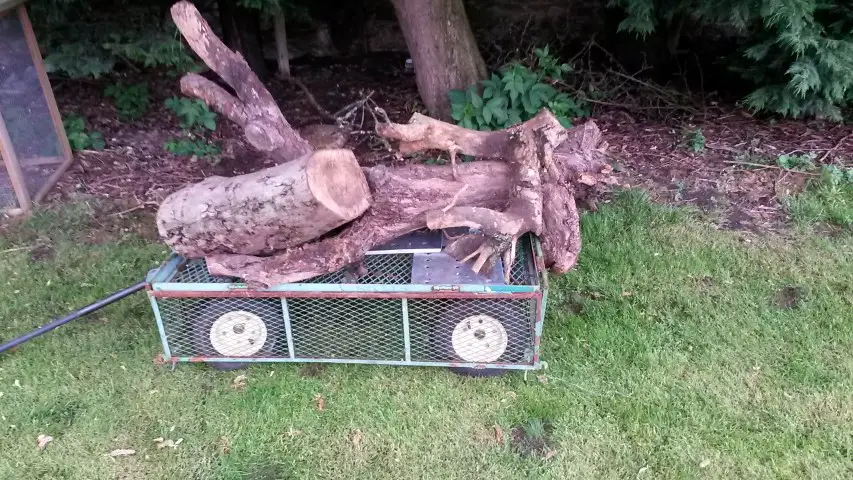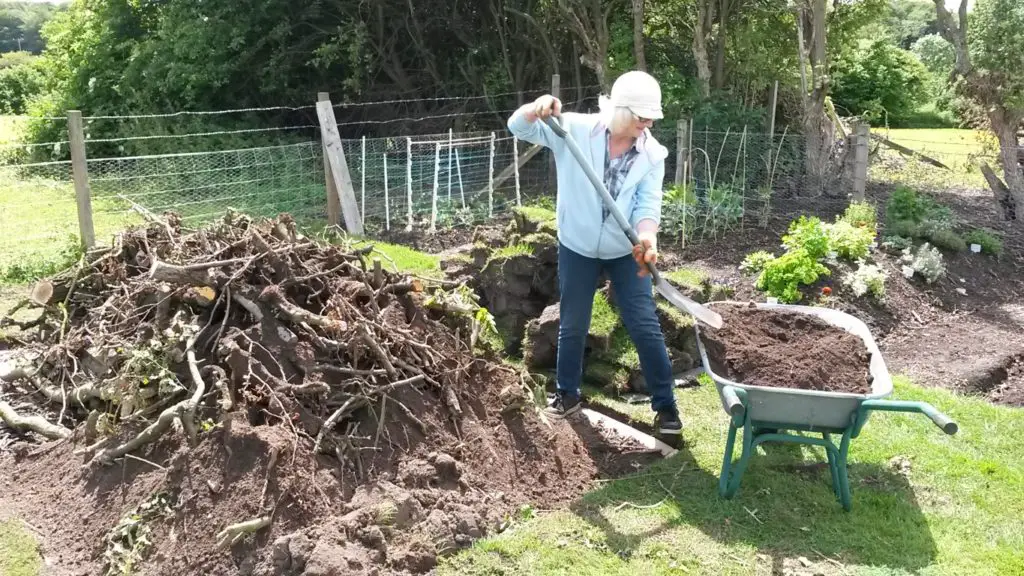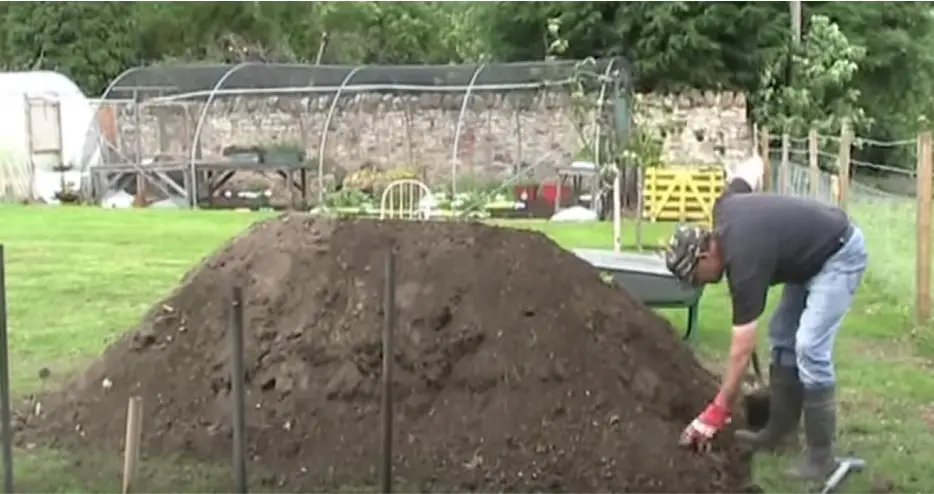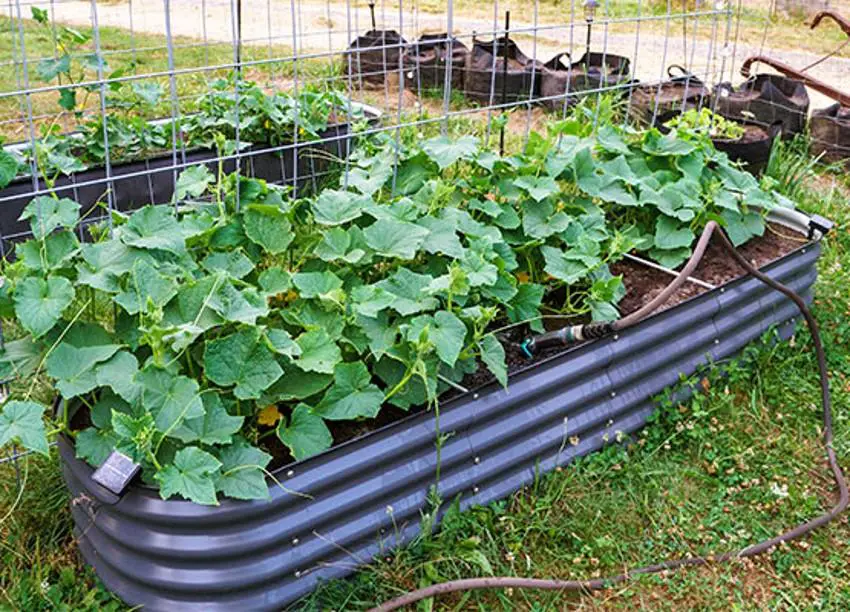With the Autumn season ending and winter starting to rear its head. You may be wondering how to build a hugelkultur bed! Or maybe you think that it is time to sit by the log fire and hibernate for the winter. Forget it, there are things to be done to prepare for the Spring growing season!
season!
One of these tasks is one that will keep you nice and warm – constructing a hugelbed. Constructing a what now? You may well ask.
Best Way To Build A Hugelkultur Raised Bed
- Collect a pile of old timbers fallen branches or old tree stumps.
- Turf an area of grass approximately 6 foot by 9 foot. Put turf to one side.
- Place the largest of the timbers in the center of the area.
- Pile around the large timbers with the smaller branches twigs etc until you have a mound about 3-4 foot high.
- Once the mound is formed over the entire area, fill in the cracks with soil and smaller twigs.
- Cover complete area with the turf you removed earlier, Placing the turf Grass side down (upside down).
- Cover with a layer of topsoil 2-3 inches deep.
- Water thoroughly and leave for 3 months before planting out.
In case you don’t know – and this is highly probable – Hugelkultur (German for mound culture). Originates in the deep forests of Germany and the Eastern regions in general.
As wood was abundant and growing space limited. It made sense (and still does) to use what they had readily available. And create growing areas where otherwise it was impossible.
where otherwise it was impossible.
Thus the idea of Hugelkultur was born. A Hugelkultur is a mound made up from (mostly) old rotten wood. With some green material (leaves, grass, etc) and soil thrown. This to create a fertile growing area in a clearing in the forest.
The advantages of this type of gardening – similar to a Raised Bed garden. And other no-dig gardening techniques
And other no-dig gardening techniques are as follows.
are as follows.
- A hugelkultur bed is almost totally self irrigating, after a year or 2.
- Makes use of old or rotten timber that you may have lying around.
- Creates a growing area that needs little if any fertilizer or compost.
- The dimensions of a hugelkultur makes it easy to use. Not so sore on the back as there is less bending over involved.
- Easy to weed and plant/harvest your veggies
What is a Hugelkultur Bed?
In a nutshell a hugelkultur is a combination of sticks or old wood and logs. Laid out in a heaped mound and covered over with soil or turf to create a raised growing area. Either free-standing or enclosed in a raised garden bed.
The concept of Hugelkultur Bed originated in the thick forests of Germany. where wood was plentiful but cultivable land was not.
What Lumber To Use To Build A Hugelkultur:
Any old (or new) wood except anything that has been treated against rot. Also avoid rot-resistant timber such as oak or cedar. Larger lumber makes up the base and as the heap grows then smaller sticks to infill. Old broken timbers or even fencing material can be used to form the core of your Hugelbed.

Finally top it off with turf or topsoil.
Now you might understand why it is such a good idea for the autumn/winter seasons. It certainly warms you up with all the hard labour involved 🙂
As far as timber is concerned, the more rotten it is the better it will work. The idea is that as the lumber rots down it becomes like a honey-comb and absorbes any moisture that is in the air.
This means that as the heap matures it becomes self-irrigating. To the point that a good soaking twice per growing season is enough to sustain it over a dry summer period.
So there you have it – Hugelkultur. How to build your own Hugelkultur Bed all ready for planting your fruit or vegetables in the spring! Over time the timbers decompose, making the whole mound self-feeding. As well as self-irrigating.
or vegetables in the spring! Over time the timbers decompose, making the whole mound self-feeding. As well as self-irrigating.
This means no need to fertilize at all. How long will this last? Approximately ten years or so, depending on the timbers used.
at all. How long will this last? Approximately ten years or so, depending on the timbers used.

Best Time To Build A Hugelkultur Bed:
This is an ideal task for the end of the growing season. It makes use of any old fall timbers and forest debris you may have lying around. Even the Fall leaf-moult can be used to fill in the gaps around the branches.
Once you have finished building the mound, making sure you have filled in all the gaps. With green material like grass clippings for nitrogen. You can then add the turf you removed earlier and pack it grass-side down onto the hugelbed .
.
Finally coat the whole mound with a layer of topsoil at least a couple of inches deep – more if you do not have turf to add.
By the Spring time (if you have started this in the Autumn/winter period). You will find that the mound has settled down a bit. That’s ok and to be expected. Top off with more topsoil, filling in any holes that have appeared due to settlement.

The Hugelbed is complete with the topsoil added. Now to let it settle for a few weeks before planting – preferably into the Spring growing season
What can you grow in a Hugelkultur Bed?

Metal Raised Garden beds like this one, can also be used to set up and contain a Hugelkultur.
like this one, can also be used to set up and contain a Hugelkultur.
There is virtually no limit to the different vegetables or herbs that can be grown in a Hugelkultur. However deep tap-root vegetables like carrots or parsnips for example. Are not ideal as their root will likely become deformed when they hit the timber below the surface.
Also for this reason Potatoes are not advised. How are you going to harvest them without destroying the hugelkultur bed?
Any vegetable that grows on the surface like cabbage, cauliflower, broccoli, pak choi. These are fine for a Hugelbed.
Turnips and radish grow well. Likewise any of the legume family will grow well with the addition of a framework added to the bed.
The main thing is to use your imagination! Whatever naturally grows well in your area should grow and prosper in a Hugelkultur.
HUGELKULTUR ON AMAZON
Recomended for you – Raised Bed Lasagna Gardening



